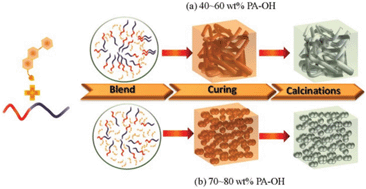When we blended the diblock copolymer poly(ethylene oxide-b-ε-caprolactone) (PEO-b-PCL) with the monomer (3-phenyl-3,4-dihydro-2H-1,3-benzoxazin-6-yl)methanol (PA-OH), Fourier transform infrared (FTIR) spectroscopy revealed that the ether groups of the PEO block were stronger hydrogen-bond acceptors for the OH group of PA-OH than were the C![[double bond, length as m-dash]](https://www.rsc.org/images/entities/char_e001.gif) O groups of the PCL block. Thermal curing resulted in the block copolymer being incorporated into the polybenzoxazine resin, forming cylindrical, wormlike, and disordered spherical nanostructures through a mechanism involving reaction-induced microphase separation, as evidenced using transmission electron microscopy (TEM) and small-angle X-ray scattering (SAXS). Wormlike micelles of PCL, formed as the second phase in polybenzoxazine at a high aspect ratio, appearing to possess the optimal length scale to result in greater toughness. Mild pyrolysis conditions led to removal of the PEO-b-PCL diblock copolymer and formation of mesoporous polybenzoxazines. This approach also provided composition-dependent nanostructures that were similar to the structures of the non-pyrolyzed samples. Regular mesoporous polybenzoxazine resin was formed only when the polybenzoxazine content was 40–70 wt%. Intriguingly, the structures were affected not only by the balance between the contents of the polybenzoxazine and the diblock copolymer but also by the curing temperature and process.
O groups of the PCL block. Thermal curing resulted in the block copolymer being incorporated into the polybenzoxazine resin, forming cylindrical, wormlike, and disordered spherical nanostructures through a mechanism involving reaction-induced microphase separation, as evidenced using transmission electron microscopy (TEM) and small-angle X-ray scattering (SAXS). Wormlike micelles of PCL, formed as the second phase in polybenzoxazine at a high aspect ratio, appearing to possess the optimal length scale to result in greater toughness. Mild pyrolysis conditions led to removal of the PEO-b-PCL diblock copolymer and formation of mesoporous polybenzoxazines. This approach also provided composition-dependent nanostructures that were similar to the structures of the non-pyrolyzed samples. Regular mesoporous polybenzoxazine resin was formed only when the polybenzoxazine content was 40–70 wt%. Intriguingly, the structures were affected not only by the balance between the contents of the polybenzoxazine and the diblock copolymer but also by the curing temperature and process.

You have access to this article
 Please wait while we load your content...
Something went wrong. Try again?
Please wait while we load your content...
Something went wrong. Try again?
![[double bond, length as m-dash]](https://www.rsc.org/images/entities/char_e001.gif) O groups of the PCL block. Thermal curing resulted in the
O groups of the PCL block. Thermal curing resulted in the 

 Please wait while we load your content...
Please wait while we load your content...